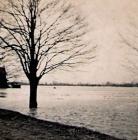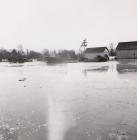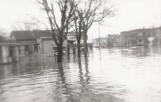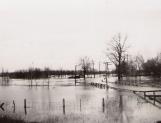1
Lemuel Sherman in boat on Sherman Farm
20th Century, Circa 1950
Thamesville, Ontario, Canada

2
Local resident, Lewis Sherman, lived just south of the CNR railway tracks that lie on the outer edge of the village. He was in clear view of the Thames River. Just 8 years old at the time of the 1937 flood, he remembers that his mother who had been listening to the warnings on the radio, gave him strict orders to stay on their porch. Lewis can still recall the wave of water that broke over the bank of the river and began to cover the acres of farmland that lay between the banks of the river and the village. As Lewis’ family watched the water spill over the banks and creep towards their home, his mother began to fret while his Uncle Edgar nonchalantly said, "Don’t worry! Look at all the ground it has to cover before it reaches us." However, it did not take long for the Thames River to pour onto their lawn and into their home. "The water began to reach us at 7a.m. I remember watching ugly dirty brown water coming over and covering my mother’s daffodils."
3
Sherman House
April, 1937
Thamesville, Ontario, Canada

4
Barns
April, 1937
Thamesville, Ontario, Canada

5
As the water around the Sherman farm continued to rise, Lewis’ mother began to worry about the young baby chicks that were in their barn. Lewis can still recall to this day how his mother brought those baby chicks into their home. Lewis was in charge of keeping the chicks under the warmth of the wood stove in their kitchen. While Lewis and his mother were able to save most of the baby chicks, their belongings that had been outside and in the barns were lost. The floodwaters had washed away items such as the fence and their wooden milking stools. "We lost everything that would float."
6
Flood Corner
April, 1937
Thamesville, Ontario, Canada

7
Lloyd Mitton was a long time resident of Thamesville and he vividly remembers the turmoil of the great flood of 1937. Lloyd was 18 years old at the time of the flood and he remembers how excited he was when he awoke on April 28th to find water surrounding their home at 126 London Road. "In typical teenager response, I severed the ridge with my shoe, claiming that our house was the first surrounded in the village. Of course, that was only speculation."
8
Moving to Higher Ground
May, 1937
Thamesville, Ontario, Canada

9
Lloyd immediately made his way uptown in the shallow water to explore. He headed over to help Jim Sherman save some of his chickens. Once the water broke through the railroad culvert and the floodwaters rushed into the streets of Thamesville, Lloyd was forced to flee to his home like many other citizens. The water was rising quickly. Once it reached to about six inches below their floors, Lloyd and his family moved to Mrs. McFarlane’s house next door which was much higher.
10
Somewhere on a Thamesville Street
April, 1937
Thamesville, Ontario, Canada

11
An especially heroic tale that Lloyd tells of the flood is one involving their cat, Conacher, that got itself into quite a predicament. When Lloyd’s family was in the process of moving next door they heard the cat meowing from under the house. "We heard him plainest at a cold air register so I took a screw driver and after ruining the register, I reached under a timber, felt the cat’s foot and pulled him through the water under the timber to safety."
12
Little Creek Bridge
May, 1937
Thamesville, Ontario, Canada

13
After Lloyd had saved their cat he remembered Sandy, the contest pony. Sandy was tied up at a stable at 57 Ann Street so he called the Hubbell boys who lived at 59 Ann Street to see if they would untie Sandy and get him to higher ground. The boys were not home so their mother, Mrs. Garnet Hubbell, waded through the water in her rubber boots to release Sandy. Sandy was able to find a patch of higher ground at Jimmy Brown’s bush south of the Fairgrounds. The pony stayed on this patch of land for two days during the flood, going without food or fresh water.
14
Men on Raft
April, 1937
Thamesville, Ontario, Canada
